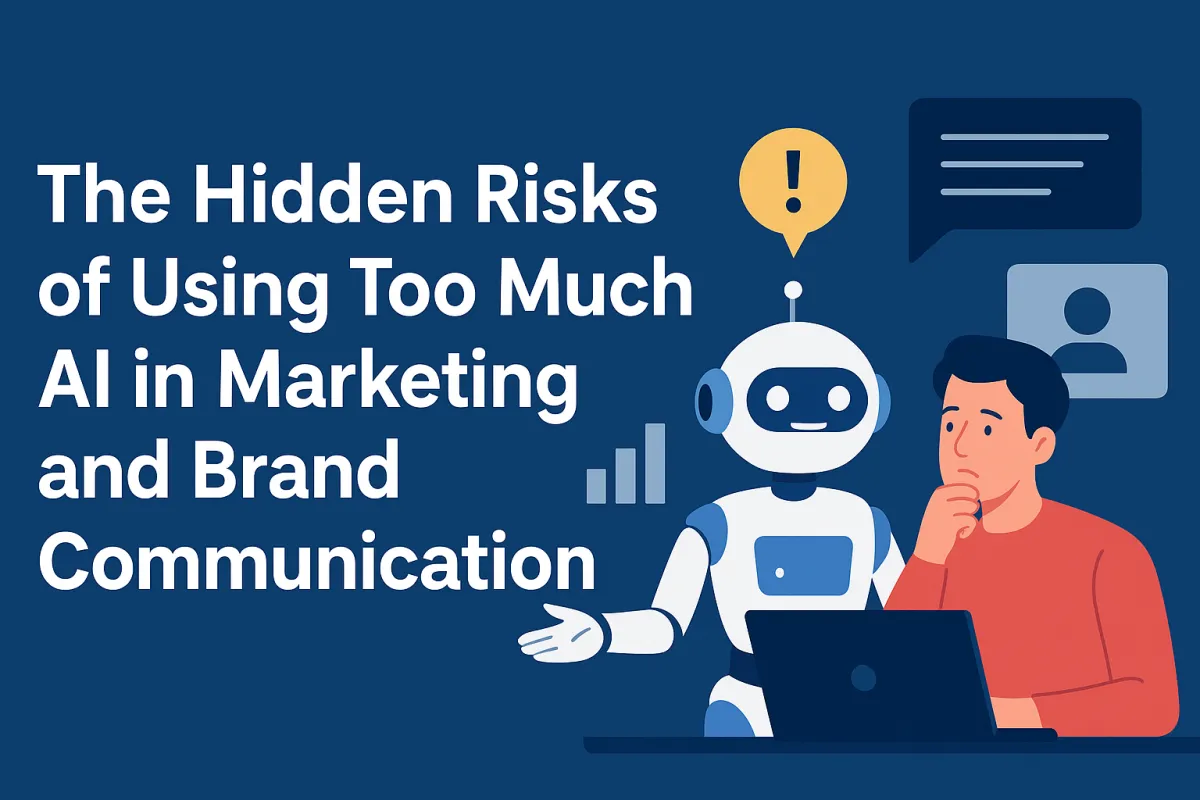
The Hidden Risks of Using Too Much AI in Marketing and Brand Communication
Artificial Intelligence (AI) has transformed the way businesses approach marketing and brand communication. From personalized emails and automated chatbots to predictive analytics and content generation, AI tools have made processes faster, smarter, and more efficient. However, as powerful as these tools are, relying too heavily on them comes with hidden risks. If not managed properly, overusing AI can negatively affect brand reputation, customer trust, and overall business growth.
In this article, we’ll explore the key risks of excessive AI use in marketing and brand communication, and how businesses can strike the right balance.
1. Loss of Authentic Human Connection
One of the most significant risks of overusing AI is losing the human touch in brand communication. While AI can personalize messages, it often lacks genuine empathy and emotional intelligence. Customers want to feel understood and valued—not like they’re speaking to a machine.
For instance, automated responses may resolve simple queries, but when a frustrated customer encounters repetitive or robotic answers, it can damage their trust in the brand. Over time, this lack of authentic interaction can make a company appear cold and disconnected.
2. Risk of Generic and Repetitive Content
AI-driven tools are excellent at producing large volumes of content quickly. But the downside is that such content often lacks originality, creativity, and brand personality. When companies rely too much on AI-generated blogs, emails, or social posts, their messaging may start to sound repetitive or too similar to competitors using the same technology.
This can dilute a brand’s unique identity, making it harder to stand out in crowded markets. Consumers can also detect when content feels “too robotic,” which can hurt engagement and reduce credibility.
3. Dependence on Data Accuracy
AI systems heavily rely on data to deliver accurate insights and predictions. If the data fed into AI platforms is incomplete, outdated, or biased, the results can be misleading. Overdependence on these flawed outputs may lead businesses to make poor marketing decisions.
For example, targeting the wrong audience, misinterpreting customer behavior, or relying on inaccurate sentiment analysis can waste resources and damage brand perception. Customers may feel misunderstood if they consistently receive irrelevant ads or messages.
4. Ethical Concerns and Consumer Backlash
Modern consumers are becoming increasingly conscious of how brands use AI and data. If customers feel that AI is being used unethically—such as excessive data collection, intrusive personalization, or manipulative algorithms—it can trigger backlash.
For instance, over-targeted ads may make consumers feel like their privacy is being invaded. This not only harms customer trust but can also spark negative publicity, legal issues, or regulatory scrutiny, all of which damage brand reputation.
5. Risk of Over-Automation in Customer Support
Customer service is a key area where brands deploy AI, especially through chatbots and automated response systems. While these tools can handle basic queries effectively, over-automation can frustrate customers who want to speak to a real person for complex issues.
A poor support experience can quickly spread online through reviews and social media, magnifying the damage to a brand’s image. The absence of human intervention in critical situations makes customers feel undervalued and ignored.
6. Reduced Creativity and Innovation
AI is excellent at analyzing existing patterns, but it struggles with true innovation and out-of-the-box thinking. When companies depend too heavily on AI for campaign strategies or creative direction, they risk limiting their brand’s ability to inspire and connect emotionally with audiences.
Marketing is not just about efficiency—it’s about storytelling, emotion, and building relationships. If every campaign feels formulaic because it’s AI-driven, the brand risks becoming forgettable.
7. Negative Impact on Brand Trust and Authenticity
Today’s consumers value authenticity more than ever. They want to know the “people” behind a brand, not just the technology powering it. If a company’s communication appears overly automated or artificial, customers may start questioning whether the brand truly understands them.
Trust takes years to build but only moments to lose. Too much AI can create an authenticity gap that weakens long-term brand loyalty.
8. Striking the Right Balance: Human + AI
While the risks are real, it’s important to note that AI itself isn’t the enemy—it’s the overuse and misuse that causes harm. The key is balance. Businesses should use AI to enhance human effort, not replace it entirely.
Use AI for efficiency: data analysis, customer insights, and personalization.
Keep humans in control of creativity, storytelling, and emotional engagement.
Ensure transparency in how AI and data are being used.
Regularly monitor AI-driven outputs to maintain brand consistency and authenticity.
Conclusion
AI has undoubtedly revolutionized marketing and brand communication, offering businesses powerful tools to connect with customers in smarter ways. However, over-reliance on AI comes with hidden risks—ranging from loss of authenticity and creativity to ethical concerns and damaged customer trust.
To protect brand reputation, companies must strike a balance between automation and human connection. By combining the efficiency of AI with the empathy, creativity, and authenticity of humans, businesses can build stronger, more trustworthy brands in the digital age.